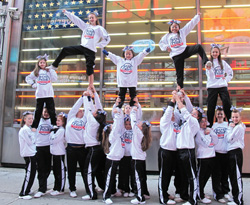Get the Best Kid-Friendly Activities
Sent to You Weekly!
The seriousness of head, neck, and back injuries may be one of the reasons that all-star coaches look for good tumbling and stunting techniques. Strong, technically sound athletes are less likely to sustain a severe injury or contribute to a teammate’s injury.
Students interested in participating on their high school team should be able to tumble, perform jumps, and have good motion techniques. Effort and commitment are important at this level because coaches look to build a complete team with athletes that complement one another other.
Those who don’t make the cut may need to take a tumbling class, get stronger, or talk to the coaches about their weaknesses and the team’s future needs.
“Cheerleading isn’t just a team sport,” Albano says. “The athletes really have to work together as one. It’s more like a puzzle—if there is one piece missing, it won’t work. They have to trust each other and work together. When you are lifting girls and tumbling right next to each other, you have to trust that everyone is doing what they’re supposed to be doing at the right time.”
Team Dynamics—and Boys
One trend that’s changing the dynamic of teams across the nation that Albano has witnessed first-hand is the addition of male cheerleaders to many rosters. Although boys who participate may face different emotional challenges than girls, males experience the same physical and emotional benefits from being part of the group.
“Parents should support their children and help them develop positive self-esteem,” says Bachman, who encourages children to participate in sports, especially those they excel in, to build their self worth.
Parental support doesn’t guarantee that male cheerleaders won’t be tormented by their peers. It is an unfortunate reality that there are those who question the sexuality of boys who are interested in joining high school cheerleading teams, and may do so loudly. Parents, beyond lending support, should offer tips on how to deal with bullies. Bachman suggests that children address a bully directly, tell him to stop—being sure to avoid physical retaliation—and report the incident. If parents are aware of bullying, they can work with school leaders to develop anti-bullying programs that educate students and parents about the short- and long-term effects of bullying.

Albano, who coached a team with male cheerleaders for the first time last year, immediately noticed a difference in the group’s dynamic. The girls, who were learning new stunts and choreography, were a little distracted at first, but the team’s collective confidence soared.
“It helps make the team feel they can do better,” says Albano, who noted the boys’ strength and athleticism was unparalleled.
Another local team has had several boys on their roster for the last few years. “My observation of the boys on their team is that they seem like leaders and role models,” Albano says. “They motivate the girls, and the team seems like a big, happy family.”






